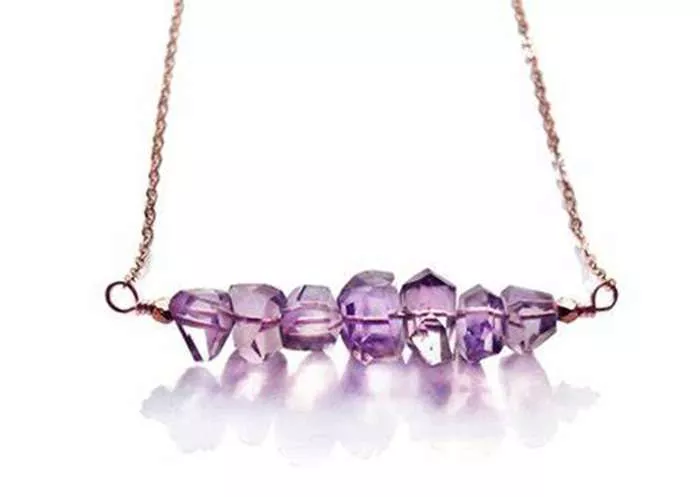Amethyst, the vibrant purple variety of quartz, has long captivated jewelry designers and wearers alike. As the birthstone for February, it holds a unique position in the realm of gemstones, blending historical symbolism, aesthetic versatility, and practical durability. When designing necklaces—a jewelry category that demands both visual harmony and functional longevity—amethyst often emerges as a preferred choice over other birthstones.
Aesthetic Versatility: The Power of Purple
Amethyst’s signature purple hue, ranging from pale lavender to deep violet, offers unmatched flexibility in necklace design. Unlike monochromatic stones (e.g., diamond) or overly saturated gems (e.g., ruby), amethyst’s color spectrum adapts to diverse aesthetics:
Soft Tones: Lighter amethysts complement minimalist designs, such as solitaire pendants or delicate chain necklaces.
Rich Hues: Deep violet stones anchor bold statement pieces, pairing well with gold settings or intricate filigree.
Color Harmony: Purple naturally bridges warm and cool tones, allowing amethyst to harmonize with metals like rose gold, yellow gold, or platinum, as well as accent gems like citrine or peridot.
In contrast, birthstones like emerald (May) or peridot (August) have narrower color ranges, limiting their adaptability across design styles.
Durability and Wearability
Necklaces endure daily wear, making durability a critical factor. Amethyst ranks 7 on the Mohs hardness scale, comparable to garnet (6.5–7.5) but softer than sapphire (9). However, its balanced toughness makes it resilient against scratches and chips while remaining easy to cut and polish. Key advantages include:
Resistance to Fading: Unlike opal (October birthstone), which is prone to cracking, amethyst maintains its color integrity under normal wear.
Low Maintenance: Unlike pearls (June), which require careful cleaning, amethyst can withstand ultrasonic cleaners and mild chemicals.
Affordability: High-quality amethyst is more accessible than rare gems like tanzanite (December), allowing designers to create intricate necklaces without prohibitive costs.
Symbolic and Cultural Resonance
Amethyst’s rich symbolism enhances its appeal in birthstone necklaces, which often carry personal or emotional significance:
Historical Legacy: Ancient Greeks associated amethyst with sobriety and clarity, while medieval clergy wore it to symbolize piety. This heritage adds depth to modern designs.
Metaphysical Beliefs: Many wearers value amethyst for its purported calming energy, aligning with the intention-driven trends in jewelry (e.g., “healing crystal” necklaces).
Universal Appeal: Unlike niche stones like topaz (November), amethyst’s purple transcends gender and age, making it suitable for unisex or multi-generational designs.
By comparison, birthstones like bloodstone (March alternative) or sardonyx (August) lack this universal cultural cachet.
Design Innovation and Craftsmanship
Amethyst’s physical properties inspire creativity in necklace construction:
Cutting Flexibility: Its vitreous luster and transparency allow for diverse cuts—from classic emerald shapes to freeform cabochons—enhancing light play in pendant designs.
Size Variety: Large amethyst geodes can be sliced into bold focal beads, while smaller stones suit stacking or charm necklaces.
Mixed-Material Pairings: Amethyst pairs elegantly with materials like oxidized silver, enamel, or even wood, supporting bohemian, modern, or vintage aesthetics.
In contrast, harder gems like diamond or sapphire require specialized tools for intricate carving, increasing production costs.
Market Trends and Consumer Preferences
Modern jewelry trends favor versatility and storytelling, areas where amethyst excels:
Personalization: Amethyst birthstone necklaces can be layered with zodiac charms or engraved nameplates, aligning with the demand for customizable jewelry.
Ethical Sourcing: Amethyst is widely available from ethical mines in Brazil, Uruguay, and Zambia, contrasting with controversial gems like mined diamonds.
Fashion Synergy: Purple’s dominance in seasonal fashion (e.g., Pantone’s 2022 “Very Peri”) boosts amethyst’s relevance in statement necklaces.
Challenges and Comparisons
While amethyst holds many advantages, it’s important to contextualize its limitations:
Color Stability: Prolonged exposure to sunlight can fade some amethysts, though this is less critical for necklaces (vs. rings).
Perceived Value: While affordable, amethyst lacks the “investment” prestige of sapphires or emeralds. However, this aligns with the growing preference for accessible luxury.
Conclusion
This analysis explores the multifaceted qualities of amethyst that make it ideal for necklace designs, including its color psychology, material properties, cultural resonance, and design adaptability, while contrasting it with gems like garnet (January), aquamarine (March), or diamond (April).
Related topics:
How to Cleanse Pink Amethyst and Maintain Its Energy?
Which Regions’ Antique Markets Are Famous for Amethyst Necklaces?
How to Handle Oxidized Antique Silver – Set Amethyst Necklace?


